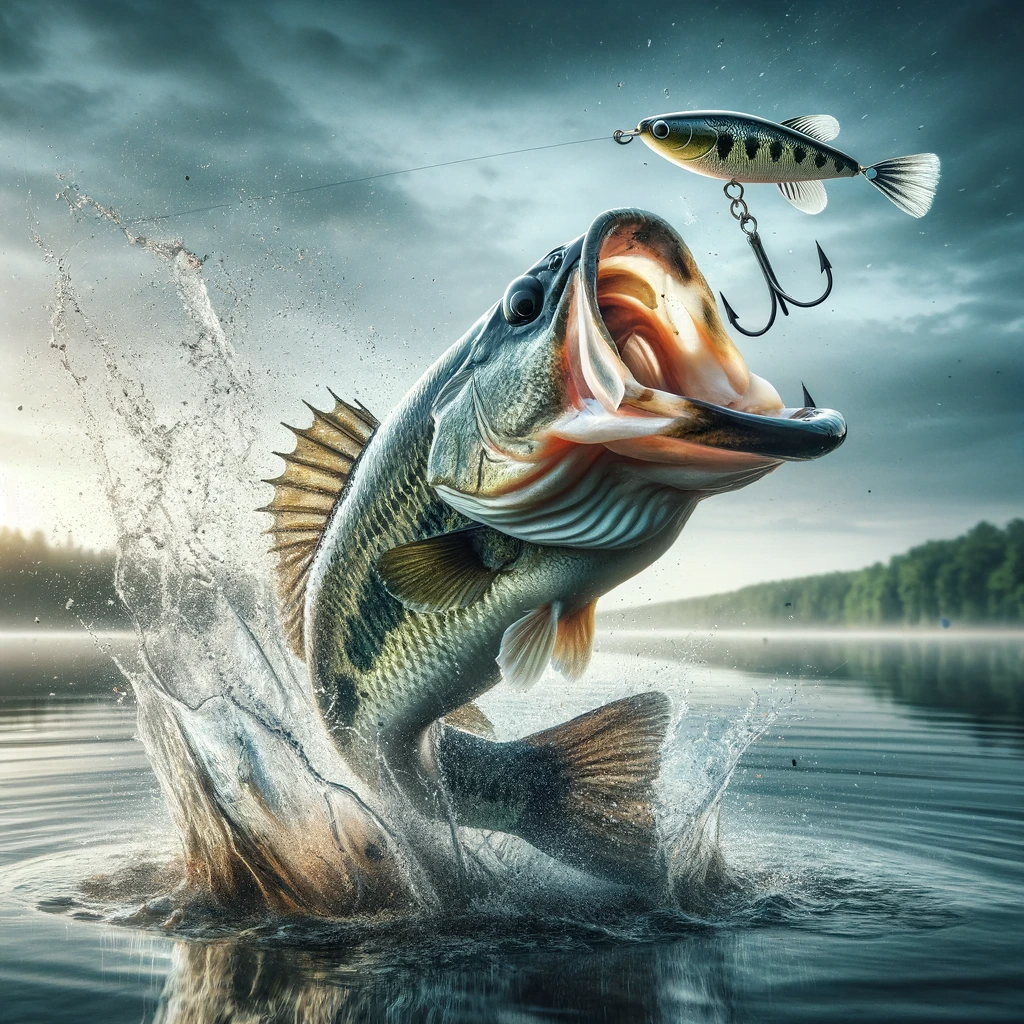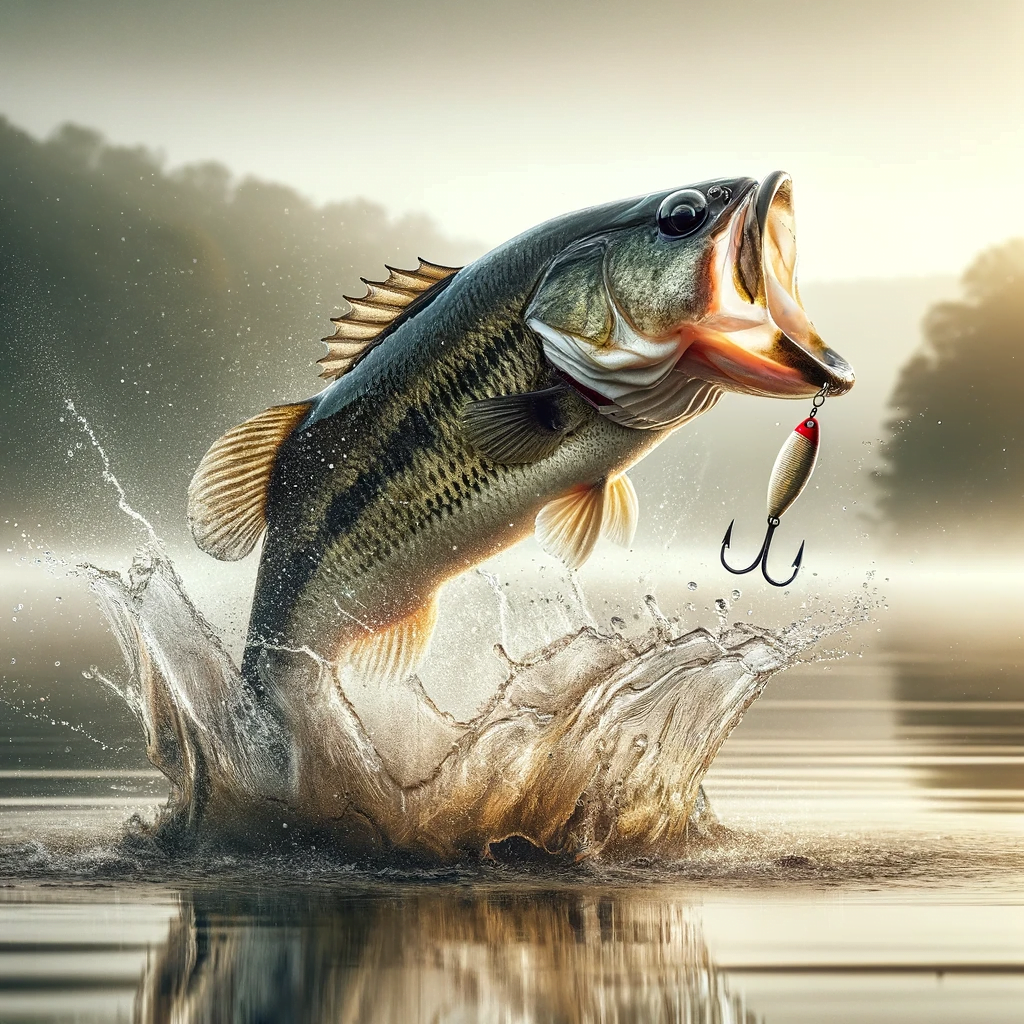ChatterBaits are one of the most effective and versatile lures for catching bass year-round. The unique vibrating and rattling action of a ChatterBait triggers explosive reaction strikes from bass unlike many other lures. In this in-depth guide, we’ll cover everything you need to know about using ChatterBaits for catching more and bigger bass. So… Are Chatterbaits Good For Bass?

What Makes ChatterBaits Such a Deadly Big Bass Bait?
A ChatterBait is a hybrid bladed jig that combines qualities of a spinnerbait and a jig all in one potent package. The hexagonal or rectangular blade creates strong vibrations and an erratic side-to-side motion. This highly erratic action triggers reaction strikes from ambush predators like bass when other lures fail to produce.
ChatterBaits were designed by Z-Man Fishing tackle company to mimic wounded baitfish, crawfish, and other forage that bass key in on. The unique wide wobble and vibration imitates struggling prey. When bass feel and hear that vibration with their lateral lines, they instinctively attack it.
The blade on a ChatterBait thumps, clacks, and chats as it comes through cover and structure. These are the types of noises that bass associate with feeding opportunities. The louder the racket, the more strikes you’ll get.
Many pros rely heavily on ChatterBaits early and late in the year when water temperatures are cold. Bass metabolism is slower in cold water, so reaction baits are key. The vibration of a bladed jig can elicit bites when finesse presentations come up empty.
Once bass move shallow to spawn, a ChatterBait dragged over staging areas becomes a lethal technique. The chance of hooking the trophy bass of a lifetime goes way up when fishing a bladed jig in the spring.
While ChatterBaits truly shine for shallow water applications, don’t underestimate them for offshore fishing. Dragging a bladed jig over submerged roads, ditches, humps, and contour changes can put bass in the boat when crankbaits and jigs struggle to produce.
ChatterBait Styles, Skirts, Blades and Trailers for Bass
There are two main types of ChatterBaits to choose from:
- Bladed Jigs: The original style with an exposed offset hook and rubber skirt. Allows for greater action and a bigger profile. The go-to for clear water.
- Traditional ChatterBaits: The bladed head is concealed by a bullet or coffin shaped mold. Much more weedless and snag-resistant. Better for heavy cover.
The willow leaf blade and Colorado / Indiana blade profiles work best for matching baitfish forage that bass feed on. Go with larger blades up to 1 oz or greater for maximum vibration and thump. The bigger the blade, the more reaction bites you’ll trigger.
Adding a swimming grub or creature bait trailer behind the jig further enhances action and increases the overall profile of the presentation. Match the hatch by picking trailer colors that mimic the forage in the lake or river you’re fishing. White and shad imitations are universal go-tos.
The skirt on a bladed jig can make a difference as well. Contrasting colors between the jig head and skirt help the entire bait stand out. In clear water, go with translucent or more natural skirt colors. For muddy water, choose solid neon and brightly colored skirts for better visibility.
Gear and Equipment Recommendations for Fishing ChatterBaits
Having the right rod, reel, line and tackle makes a huge difference when fishing ChatterBaits:
- Rod: A 7-7’6″ medium-heavy or heavy power fast action rod is ideal. The strong backbone ensures you can rip it free from snags and brush.
- Reel: Pick a high speed 6.3:1 and higher gear ratio casting reel. This allows keeping up with the fast vibration of the blade.
- Line: 15-20 lb fluorocarbon or braided line provides abrasion resistance around wood and weeds where ChatterBaits shine.
- Leader: A 2-3 foot fluorocarbon leader of 12-15 lb test helps prevent line twists and added invisibility.
- Hook: Upgrade the hooks to stronger models like Owner or Trokar for better hooksets.
- Accessories: Consider a trailer keeper for soft plastic trailers to prevent losing them and maximize action.
ChatterBait Fishing Techniques, Tips and Tricks
Follow these key techniques and strategies for maximizing success with ChatterBaits:
- Focus on casting ChatterBaits around shallow shoreline cover and structure. Target areas like laydowns, brush piles, stakebeds, breakwalls, points, and flooded vegetation.
- Let the bladed jig sink to the bottom, then use a steady retrieve mixing up occasional pauses for an erratic fleeing crawfish action.
- Use rod snaps during the retrieve to make the lure pop and change directions. This triggers reaction strikes.
- Reel steadily on the retrieve and don’t hesitate to power through thick grass and vegetation. The blade will deflect off most underwater obstacles.
- If snagged in thick cover, don’t gently pull. Aggressively rip the lure free with a hookset to utilize the strength of braided line or fluorocarbon.
- In open water around scattered grass or offshore structure, use a stop-and-go retrieve pausing 3-5 seconds between steady reel cranks.
- Try burning the ChatterBait just below the surface like a buzzbait over matted grass or vegetation. This triggers explosive topwater strikes.
- Use trailer keepers and plastics like Z-Man’s ElaZtech to prevent soft plastics from tearing over time.
Prime Conditions and Scenarios for Throwing a ChatterBait
While versatile enough for year-round bassing, ChatterBaits shine in these key scenarios:
- Cold Water: Early spring and late fall when water temps are below 60 degrees. The vibration elicits reaction bites.
- Stained Water: Lower visibility conditions where the vibration helps bass hone in. Great for river fishing.
- Shallow Water: Anytime bass are in 5 ft or less of water, it’s ChatterBait time.
- Sparse Vegetation: Situations where there’s scattered grass, wood, or other shallow cover to rip it through.
- Post-Front: Tough bite conditions when reaction style baits are key to triggering bites.
- Pressured Fish: Heavily fished lakes where bass are conditioned to ignoring normal lures.
- Pre-Spawn: Fish are staged shallow prepping for the spawn and aggressive.
- Spawning Season: When targeting big females on beds or draw them away from beds.
Why ChatterBaits Outperform Other Bass Lures
There are several key reasons why ChatterBaits can outproduce spinnerbaits, swim jigs, crankbaits and other lures in many situations:
- The unique wide wobble and vibration is far more erratic, mimicking wounded baitfish extremely well.
- ChatterBaits allow fishing very shallow water and around thick cover better than most lures.
- The blade vibration produces sound and resonance bass can home in on from a distance.
- They trigger reaction strikes from inactive, neutral fish unlike any other lure.
- Advanced models offer versatility to mimic craws, baitfish and other prey.
- Easy to fish for all skill levels. Just cast, wind, and hang on!
Expert ChatterBait Tips and Tricks
Follow these advanced tips and tricks from the pros to take your bladed jig game to the next level:
- Use trailer keepers like the Z-Man Pro Elite ChatterBait Trailer Keeper for soft plastic trailers. They prevent losing trailers and maximize action.
- Go with larger, heavier blades up to 1 oz and bigger for increased vibration and slower sink rate in cold water scenarios.
- For clear water lakes and rivers, opt for shad colored or translucent skirts and more natural colored blades.
- In muddy water, use bright colored skirts and blades for better visibility. Orange, chartreuse and pink are top colors.
- Paint or use nail polish to make the blade tip white. This adds extra flash and visibility.
- Quickly switching colors and retrieves allows you to fine tune the presentation to whatever triggers the most bites.
- For really thick shallow cover, Texas rig your ChatterBait with a pegged bullet weight for a near weedless setup.
- When fishing offshore or in open water, use longer casts and a steady retrieve to cover water and locate active fish.
Final Thoughts on ChatterBaits for Bass
As you can see, the ChatterBait deserves a spot in every bass angler’s tackle arsenal. The unique vibrating action, ability to fish shallow, and effectiveness at triggering reaction strikes makes it one of the best power fishing lures available today.
Follow the tips outlined here and have confidence committing to a ChatterBait any time bass are in an active feeding mood, regardless of season or conditions.
One of the best aspects of blade jigs is their versatility. They can be fished at any depth, around any type of cover or structure, using various retrieves. You can burn them over grass or slow roll them at the bottom of a 30 ft channel.
Don’t be afraid to get creative with your ChatterBait tactics until you dial in what triggers the most strikes. Change retrieval speeds, cadences, kill it on the pause, and swap out trailers. This bait is very easy for anglers of any experience level to experiment with and gain confidence in.
The next time you hit the water, try starting with a ChatterBait and stick with it. It likely won’t take long before you get that heart-stopping bass thump. Once you feel the power of a 4+ lb largemouth crushing a bladed jig, you’ll be hooked!

Final Tips and Tricks
One tip to extend the life and longevity of ChatterBaits is to use a waterproof nano-oil on the skirt and blade. Reapply the oil lubricant every few trips to prevent the skirt from drying out and keep the blades swinging freely.
Always match the weight of the jig head to the depth and cover you’re fishing. For shallow water scenarios, 1/4 and 3/8 oz models allow a slow fall and better control. For depths over 10 ft, use a 1/2 oz or heavier to maintain bottom contact.
Having a variety of ChatterBait colors and blade combinations tied on and ready for action is important. Start with shad patterns for clear water. Have bright hues like chartreuse and white ready for stained conditions. Always keep a black/blue or brown/purple combo for imitating crawfish.
Don’t forget that blades deteriorate over time after lots of strikes. Always check your ChatterBaits and replace blades that have lost their shine or shape. Sharper more vibrant blades equate to more bites.
Pay close attention after landing a bass on a ChatterBait. Check the area of the mouth where the hook penetrated. If you consistently see strikes on the underside of the mouth, add a trailer hook for better hook ups.
And when targeting smallmouth or spotted bass, opt for craw or shrimp imitations over shad patterns. Match the hatch to the primary forage and increase your odds of success.
Make sure to use a braided line if fishing around heavy thick cover where it’s likely you’ll need to rip or power the bait free from snags. Braid prevents losing your lure and allows putting maximum pressure on fish.
While bass fishing tournaments have been won on ChatterBaits alone, don’t hesitate to mix it up and alternate with soft plastics, topwaters, swimbaits and other reaction baits in the same area.
If the aggressive reaction strike bites shut down, be ready to slow down with finesse tactics like shaky heads, Ned rigs and wacky rigs to keep catching fish.
Wrap up
We’ve only scratched the surface here. There are endless nuances and applications when fishing the ChatterBait. It pays off big time to gain experience and confidence with all the retrieves and scenarios where it shines.
The more time you spend tuning your bladed jig approach and dialing in presentations for your fishery, the more big bass you’ll have a chance at boating. Any angler serious about trophy bass needs to take the time to truly master the ChatterBait.
The question “are ChatterBaits good for bass?” has been answered. Put this bait to the test yourself and it won’t take long before you’re a believer in its fish-catching power!




